Integrated and heterostructured cobalt manganese sulfide nanoneedle arrays as advanced electrodes for high-performance supercapacitors†
Abstract
Herein, uniform cobalt manganese hydroxide (CMOH) nanoneedle arrays were firstly prepared via a low-temperature hydrothermal process using nickel (Ni) foam as a nanoneedle growth support framework. Subsequently, stable and integrated heterostructures of cobalt–manganese sulfides (CMS) with porous structures can be simultaneously formed and grown through the reaction of CMOH with Na2S during the hydrothermal anion-exchange reaction process while retaining their intrinsic nanoneedle array structure. The as-prepared CMS nanoneedle arrays as binder-free electrodes for supercapacitors exhibit a high area capacity of 0.53 mA h cm−2 at 2 mA cm−2 and good rate performance, as well as outstanding cycle life (only 6.3% capacity loss after 1500 cycles). Based on the unique architecture and excellent electrochemical performance of CMS nanoneedle arrays, a novel CMS-8//AC asymmetric supercapacitor with a high operating voltage of 1.7 V was fabricated using CMS nanoneedle arrays as the positive electrode and activated carbon (AC) as the negative electrode, respectively, and provided a maximum specific energy of 48.5 W h kg−1 at a specific power of 524.5 W kg−1. Such excellent electrochemical behaviors suggest that the CMS nanoneedle arrays are promising electrode materials for high performance supercapacitors. Moreover, the present synthesis strategy can be extended to prepare other porous, integrated and heterostructured metal compounds.



 Please wait while we load your content...
Please wait while we load your content...